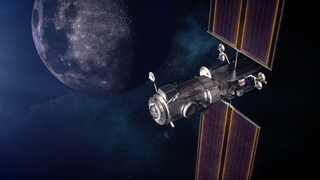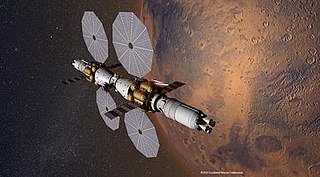 W
WThe Lunar Gateway, or simply Gateway, is a planned small space station in lunar orbit intended to serve as a solar-powered communication hub, science laboratory, short-term habitation module for government-agency astronauts, as well as a holding area for rovers and other robots.
 W
WThe Power and Propulsion Element (PPE) previously known as the Asteroid Redirect Vehicle propulsion system is a planned solar electric ion propulsion module being developed by Maxar Technologies for NASA. It is one of the major components of the Gateway. The PPE will allow access to the entire lunar surface and a wide range of lunar orbits and double as a space tug for visiting craft.
 W
WArtemis 3 is the first lunar double launch mission and third planned flight of NASA's Orion spacecraft to be launched on the Space Launch System. Scheduled for launch in September 2024, Artemis 3 is planned to be the second crewed mission of the Artemis program and the first crewed lunar landing since Apollo 17 in 1972.
 W
WThe Asteroid Redirect Mission (ARM), also known as the Asteroid Retrieval and Utilization (ARU) mission and the Asteroid Initiative, was a space mission proposed by NASA in 2013. The Asteroid Retrieval Robotic Mission (ARRM) spacecraft would rendezvous with a large near-Earth asteroid and use robotic arms with anchoring grippers to retrieve a 4-meter boulder from the asteroid.
 W
WThe Boeing Human Landing System (HLS) was the name of a proposed lunar lander concept by Boeing that was submitted by Boeing to NASA on 5 November 2019 as part of the Artemis program and the NextSTEP H. The proposal was presented as the "quickest and simplest method" for a 2024 Moon landing. The lunar lander concept was not selected for funding by NASA as part of Artemis in the 30 April 2020 announcement.
 W
WThe Deep Space Habitat (DSH) is a series of concepts by NASA that would be used to support crewed exploration missions to the Moon, asteroids, and eventually Mars.
 W
WThe Deep Space Transport (DST), also called Mars Transit Vehicle, is a crewed interplanetary spacecraft concept by NASA to support science exploration missions to Mars of up to 1,000 days. It would be composed of two elements: an Orion capsule and a propelled habitation module. As of late 2019, the DST is still a concept to be studied, and NASA has not officially proposed the project in an annual U.S. federal government budget cycle. The DST vehicle would depart and return from the Lunar Gateway to be serviced and reused for a new Mars mission.
 W
WThe European System Providing Refueling, Infrastructure and Telecommunications (ESPRIT) is a planned module of the Lunar Gateway. It will provide refueling through additional xenon and hydrazine capacity for use in the Power and Propulsion Element's ion engines. It will also provides additional communications equipment, a habitation area, and an airlock for science packages to the Lunar Gateway. It will have a mass of approximately 4,000 kg (8,800 lb), and a length of 3.91 m (12.8 ft). ESA has awarded two parallel design studies one mostly led by Airbus in partnership with Comex and OHB and one led by Thales Alenia Space. The construction of the module was approved in November 2019. On 14 October 2020, Thales Alenia Space announced that they had been selected by ESA to build the ESPRIT module.
 W
WThe Gateway Logistics Services will be a series of uncrewed spaceflights to the Lunar Gateway space station, with the purpose of providing logistical services to the Gateway. Overseen by NASA's Gateway Logistics Element, the flights will be operated by commercial providers, contracted by the agency in support of crewed expeditions to the Gateway made under the Artemis program. As of March 2020, SpaceX is the only company contracted to provide the services.
 W
WMars Base Camp (MBC) is a crewed Mars laboratory orbiter concept under study that was commissioned by NASA from Lockheed Martin in US. It would use both future and proven concepts as well as the Orion MPCV, also built by Lockheed Martin.
 W
WOrion is a class of partially reusable space capsules to be used in NASA's human spaceflight programs. The spacecraft consists of a Crew Module (CM) designed by Lockheed Martin and the European Service Module (ESM) manufactured by Airbus Defence and Space. Capable of supporting a crew of six beyond low Earth orbit, Orion can last up to 21 days undocked and up to six months docked. It is equipped with solar panels, an automated docking system, and glass cockpit interfaces modeled after those used in the Boeing 787 Dreamliner. A single AJ10 engine provides the spacecraft's primary propulsion, while eight R-4D-11 engines, and six pods of custom reaction control system engines developed by Airbus, provide the spacecraft's secondary propulsion. Although compatible with other launch vehicles, Orion is primarily designed to launch atop a Space Launch System (SLS) rocket, with a tower launch escape system.
 W
WThe Space Launch System (SLS) is an American super heavy-lift expendable launch vehicle, which has been under development by NASA since its announcement in 2011. It replaced the Ares I, Ares V, and Jupiter planned launch vehicles, which all never left the development phase. Like those proposals, it is a design derived from the components and technology of the earlier Space Shuttle.